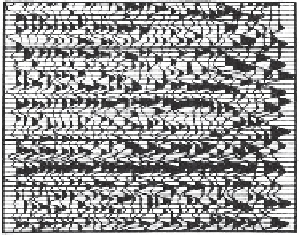Geology Reference
In-Depth Information
exploration indicators (e.g. AB ratios) for the Lisa
Anne prospect appeared to show gas but although
the well found the target sandstones it did not find
commercial pay. The explanation given was that low
saturations of gas were present within the sand-
stones. A single interface model based on the field
data (
Fig. 7.8b
) illustrates how the low gas satur-
ation can give rise to AVO similar to that of com-
mercial gas. Although low gas saturation is clearly
an issue for interpreting amplitudes it can be diffi-
cult to petrophysically determine low gas satur-
ations from well logs. Thus, it can be hard to be
definitive about a
a)
Offset (ft)
2424
11671
2.0
2.4
'
'
fizz gas
interpretation. It should
Offset (ft)
be noted that the
problem only occurs at
relatively low temperatures and pressures (Han and
Batzle
2002
).
'
fizz gas
'
b)
2860
11027
2.0
7.2.3 Class IV hydrocarbon and water sands
Although relatively uncommon, it is possible that
the tops of hydrocarbon sands and water bearing
sands both have Class IV responses. Typically this
occurs where the lithology overlying the sand has a
shear velocity significantly greater than the shear
velocity of the sand (
Chapter 5
). This scenario is
similar to the previous scenario, in that it may be
difficult to assign a hydrocarbon interpretation
simply by looking at a full stack (i.e. both water
sands and hydrocarbon sands have soft responses).
However, unlike the previous scenario, AVO projec-
tions may be useful.
Figure 7.9
(based on data from
a gas field) shows how projections can highlight the
hydrocarbon reservoir and the contact. In this scen-
ario the shale/water sand interface has a steeper
positive gradient than the hydrocarbons (
Fig. 7.9a
).
Thus, linearly projecting the AVO responses will
give an angle at which the brine sand reflectivity is
minimized. In this model this approximates to an
angle of
2.4
Figure 7.6
Tuning and AVO; (a) gather showing a Class II/III AVO
response from a productive gas zone, (b) gather showing similar
response from a tuned water wet sand (after Allen and Peddy,
1993
).
south show Class III responses with hydrocarbon
sands having amplitudes about three times brighter
than the wet sands. The differential AVO effect
between water and hydrocarbon fill in the shaley
sands is much more subtle and the shaley hydrocar-
bon bearing sands fall in the same position as the
clean water sands.
Figure 7.7c
illustrates how these
variations might impact AVO mapping. It is probable
that the AVO change will be consistent with structure
in the south but the northern boundary of the south-
ern culmination will be blurred owing to the facies
change. There is likely to be an AVO anomaly over
the northern culmination but far less dramatic than in
the south.
Another pitfall arises when low gas saturation
produces soft amplitudes and AVO signatures simi-
lar to commercial saturations (the so called
45° (
Fig. 7.9b
).
Figure 7.9c
shows how typical far angle stacks will show soft
signatures in both the water and the hydrocarbon
zone, but the reservoir will be best discriminated at
the
θ ¼
90° or
χ ¼
.
Class IV signatures are more commonly associ-
ated with hard units, such as silts and limestones,
overlying reservoir sands. The presence or absence
of a hard unit overlying porous sands can have a
dramatic effect on the AVO reflectivity.
Figure 7.10a
shows a model example from a well with a hard silt
above a sand with 30% porosity. The wet sand has a
'
fluid angle
'
'
problem) (
Chapter 5
).
Figure 7.8
shows an example
from the Green Canyon area of the Gulf of Mexico
published by O
'
fizz gas
Brien (
2004
). Gas was found at the
King Kong prospect with the two prominent high
amplitude zones representing the pay zones. All
'
130














